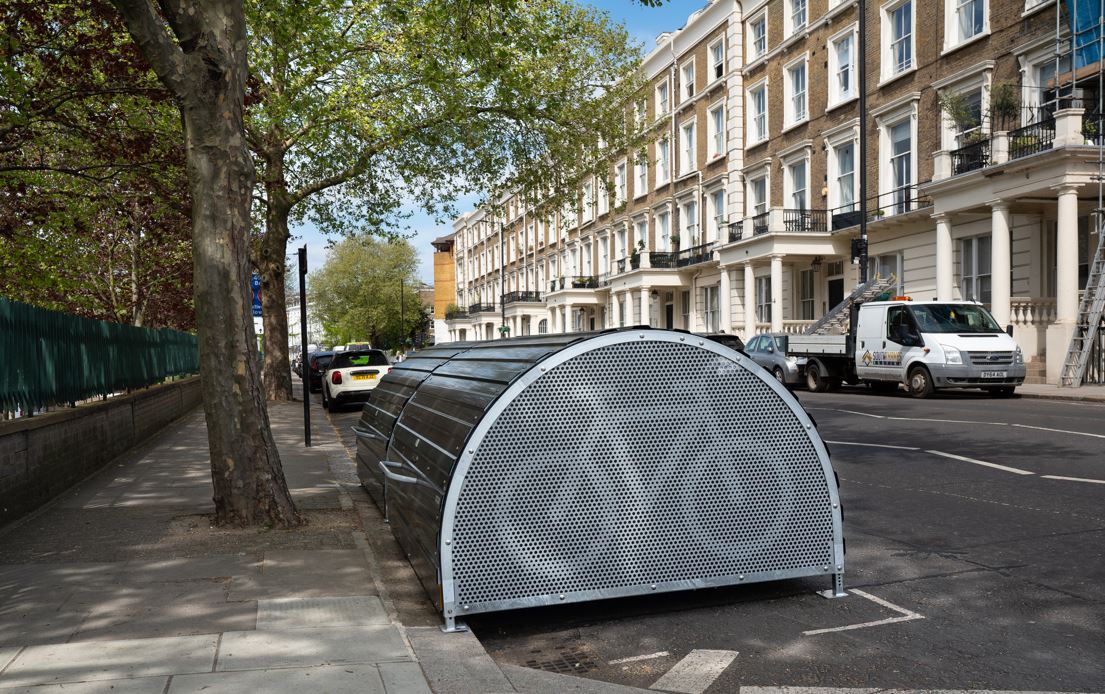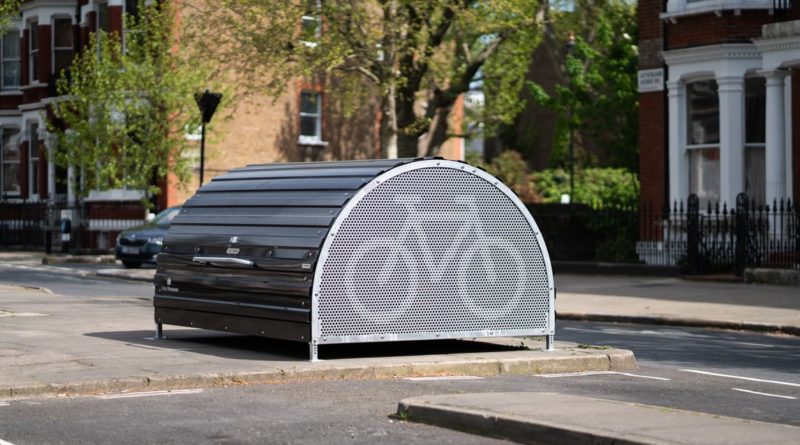Cyclehoop details its part in developing UK’s bike parking network
Cycle parking manufacturer Cyclehoop has doubled output of one of its most popular products, the bikehangar, with plans to expand manufacturing capacity by 70% next year. Laura Laker speaks to Anthony Lau to understand the reasons behind the growth.
Demand for bikehangars, which securely store up to six cycles in one car parking space, has ballooned since the start of the pandemic, with sales doubling since 2018, and the company is about to launch a new cargo bikehangar designed to store two to three cargo cycles.
Councils purchase the bikehangars, which they rent to residents on an annual basis, usually replacing car parking spaces. The number of residents on council waiting lists has ballooned to an eye-watering 40,000 people – three times the current number of bikehangar spaces. In some local authorities residents face two year waits for a space.
Lau says the rising cost of cycles, as well as a boom in cycling during the pandemic, have increased demand. “I think it just shows that it’s very popular. It’s very affordable for certain locations and there just needs to be that much more bike parking.”
“We pretty much doubled production through new manufacturing techniques,” says Lau. Cyclehoop’s manufacturer invested in new robotic equipment to keep pace with demand.
Cyclehoop is expanding its yard space in Sydenham, south London, where the bikehangars are built and stored before being shipped to on-street locations. This space, which will be ready in the first quarter of 2023, allows them to manage year-round fluctuations in orders, including when things go wrong on the installation side.
 While Cyclehoop isn’t the only parking supplier in the game, they have become a byword for secure on-street residential cycle parking. Says Lau: “We specialise in really secure and really nice [products] in terms of making them compact. There’s others who make it big or make it boxy, and you could break into all of them, some with your bare hands.”
While Cyclehoop isn’t the only parking supplier in the game, they have become a byword for secure on-street residential cycle parking. Says Lau: “We specialise in really secure and really nice [products] in terms of making them compact. There’s others who make it big or make it boxy, and you could break into all of them, some with your bare hands.”
Lau, who founded the company in 2008 after his bike was stolen, says he thinks like a bike thief when designing cycle parking. The bikehangars are Sold Secure diamond rated and Lau says “we’re trying to always make sure we upgrade them and look at new methods of attack.”
The bikehangars are all manufactured and assembled in the UK, using exclusively British suppliers; only the steel comes from India and China.
“I kind of want to always try to remind people that it’s a UK product with lots of really good UK supply chains.”
The rapidly increasing cost of steel has pushed margins, and costs up, which has forced prices up too.
The vast majority of Cyclehoop’s customers are London councils, with Glasgow and Edinburgh beginning to ramp up cycle parking provision. The Mayor’s cycle parking implementation plan estimates London needs 5,000 bikehangars to reach Hackney levels of secure on-street residential parking.
The challenge is to produce the right amount of bikehangars to avoid the risk of overstock that has crashed some companies since the pandemic cycling boom. Added to that, most councils want bikehangars delivered between January and April around spending cycles, and not all of them manage installation well.
 Lau says: “If we can get that commitment from the beginning and plan it, it can work. But if it’s sort of piecemeal, where each Council gets the funding and then they all come to us separately and then it’s a bit more challenging.”
Lau says: “If we can get that commitment from the beginning and plan it, it can work. But if it’s sort of piecemeal, where each Council gets the funding and then they all come to us separately and then it’s a bit more challenging.”
“We’re a market leading product and everyone wants them but for us, it’s trying to satisfy all those customers. But also trying to find better ways so that in the future they don’t have to all get them in January.” This includes careful forecasting work.
While some councils are experienced in installing bikehangars, others need “some hand holding”. He said: “Recently a council didn’t suspend the [parking] bays so we had a whole week’s worth of jobs that just had to be cancelled. The production team had to find new locations. But that’s where the yard would help. So we could build lots during peak times and just leave all these bikehangars built. It just gives a lot more flexibility.”
A recent report by Fare City recommended councils employ a dedicated officer to manage cycle parking, because of the challenges it poses.
For now, things show no signs of slowing down, and Cyclehoop’s new cargo bikehangar reflects changing transport trends. “I think it’s just like the bikehangar: when we started with that, people weren’t sure and then once you put them in, it just exploded. Cargo bike use is growing; it’s obviously not as much as bikes but the challenge of where do you park your bike if you’ve got an expensive bike, is a main concern. We look at Holland and other countries in Europe that use bikes so much more, so we think it will grow. If we’re serious about getting rid of cars, then cargo bikes need to be supported.” He also acknowledges the growth in larger, Dutch-style bikes may require bigger bikehangars as some upright bikes with baskets don’t fit into the current model.
Cyclehoop is also potentially looking to expand production in Scotland. Lau says: “There’s a huge drive in Scotland for secure parking and I think we can set something up there.”
The Fare City report highlighted the political concerns councils have around managing car parking, in particular raising charges. Parking a cycle on the street is often far more expensive than the cost of parking a car, in part because parking charges are so heavily subsidised. The report indicated how the bikehangars can make a case for themselves, generating demand as they are installed, something Lau echoes.
He says, ultimately: “We need to make car parking harder.”



